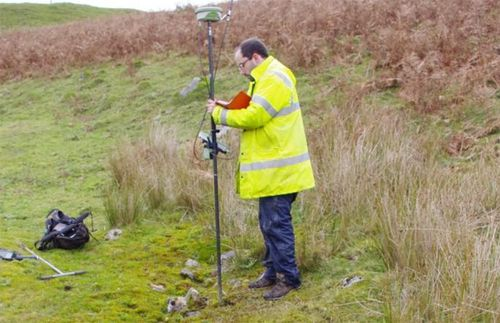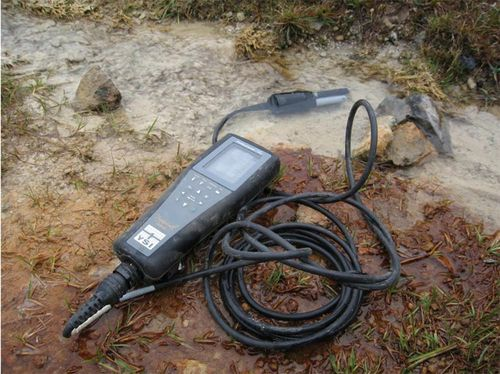OR/14/043 Survey methodology: Difference between revisions
m 1 revision imported |
|||
(No difference)
| |||
Latest revision as of 08:16, 5 April 2016
| Farr, G, Graham, J, and Stratford, C. 2014. Survey, characterisation and condition assessment of Palustriella dominated springs 'H7220 Petrifying springs with tufa formation (Cratoneurion)' in Wales. British Geological Survey Internal Report, OR/14/043. |
Site walkover
The first stage of every site visit involved a site walkover, by both the hydrogeologist (Gareth Farr) and the bryologist (Jonathan Graham). The ecological boundary of each site was then delimited by focusing on homogenous vegetation dominated by the pleurocarpous moss Palustriella commutata (incl. P. falcata). The conjectural hydrological boundary (surface water catchment and groundwater catchment) of each site was considered.
Vegetation
A complete species list was obtained for each site and the occurrence of each species recorded using the DAFOR scale. Particular note was made of species occurring at very low frequency (less than 1% cover) including species such as Creeping Bent Agrostis stolonifera, Yorkshire Fog Holcus lanatus as such species are negative indicator species for the purposes of Common Standards condition assessment when occurring in M37/M38 flushes (JNCC 2009[1]).
Flowering plants, bryophytes and lichens were identified (where possible) in the field but where there was uncertainty, specimens were collected and determined microscopically. All records of algae were determined microscopically.
The location of species of note or species occurring locally within a site or species occurring in discrete locally dominant patches were more precisely noted. This included prominent cushion-forming mosses such as Hymenostylium recurvirostrum, locally dominant stands of the large pleurocarpous moss Scorpidium scorpioides as well as various flowering plants (such as Fools Water-cress Apium nodiflorum, Marsh St John’s-wort Hypericum elodes, Bog Pondweed Potamogeton polygonifolius) which were often confined to narrow surface water runnels.
A detailed map was drawn in the field for each site noting locations of individual spring heads, runnels and tufa, and particular effort was made to accurately delimit areas of Palustriella dominated vegetation.
Topographical survey
Using a portable real time Lecia ‘Smart Rover’ GPS unit, location (x, y) and elevation in maOD (z) were recorded for key features. Survey points focused upon key features of each site including, location and elevation of spring heads, transects and site transects to calculate slope, key areas of vegetation and other markers such as river water levels. The location and elevation data were then corrected using OS RINEX (Receiver Independent Exchange Format) base station data from South Wales stations that allows the post processing of survey data to produce a more accurate result. Sufficient elevation readings were taken at each site in order to be able to calculate slope.

Hand auger, soil samples and HCI
Using an EijkelkampTM soil auger with a 150 mm head samples were taken at selected locations within each site in order to define if tufa was present and if so what was its thickness relationship to underlying deposits. The sensitive nature of these protected sites ensured that any hand auguring was undertaken with extreme care, to protect both the bryophytes and the geological conservation features. At Herberts Quarry — Foel Fawr (Mynydd Ddu SSSI) site we did not auger directly into the tufa formation as this is a key part of the Geological SSSI, and would have resulted in damage to the site. In many places at Herberts Quarry (Foel Fawr) there are opportunities to observe areas of tufa that have been eroded or downcut but water runoff, and these locations allow you to measure the depth of the tufa deposits, without damaging the site.
At some sites where the presence or absence of tufa needed to be confirmed (e.g Clydach Bridge) then hand auguring was undertaken, with descriptions of the soil being made, and photographs obtained. Where the sites were extremely sensitive (e.g Hen Allt Common, McWalters Dingle) or the tufa deposit was on a vertical face then no hand augering was undertaken. Using a small vile of HCI (hydrochloric acid) the superficial deposits and soil in the hand auger, were tested for any reaction representative of a high calcium carbonate content (represented by ‘fizzing’ of the HCI on the carbonate material).
In-situ water quality readings
In-situ water quality field readings for temperature °C, pH, specific electrical conductivity uS/cm, dissolved oxygen % and mg/l and ORP mV were collected using a YSI™ Professional Plus hand held meter. The YSI™ meter was successfully calibrated daily for dissolved oxygen and then using two pH solutions (pH 4.23 and pH 7.6), the calibration results are included within the Appendix.
| Parameter | Range | Accuracy | Resolution |
| pH | -2.60 to 16.60 | ± 0.1 mV (0.01 pH units) | 0.1 mV (0.01 pH units) |
| ORP | -1999 to + 1999 mV | ± 0.5 mV | 0.1 mV |
| Conductivity | 0.0 to 200 mS/cm | ± 0.1% FS ±1 digit for µS/cm to 0.1 mS/cm | 0.0001 mS/cm or 0.1 |
| Dissolved Oxygen | 0.00 to 90 mg/L; 0 to 550% | ± 0.2% FS (550% air saturation) ± 1 digit (with 1.25 PE membrane at 10°C) |
0.01 mg/L; 0.1% air saturation |
| Temperature | -10 to 100.00°C | ± 0.2% FS ± 1 digit | 0.1°C |
Field water quality readings were obtained from the inflows, outflows, main runnels, and along small transects within each site, and ecological and general observations were made to complement each reading. To obtained defensible field readings the YSITM meter was submerged, preferably within the area of flowing water, and left for at least 5 minutes until the readings stabilised. During this time the Leica GPS unit was used to obtain a 10 figure grid reference and elevation value. Care was taken to ensure the probes were completely submerged within the water to avoid erroneous readings.

Water quality samples & flow estimates
Water chemistry samples were collected at each site for analysis of a pre determined suite of analytes. Analysis was undertaken at the Natural Resources Wales Lab, accredited by UKAS to the current EN ISO 17025 standard. During the project the NRW labs suffered a malfunction of some key equipment and back up samples for nutrients and selected ions were sent and anylised by Alcontrol Laboratories (UKAS accredited). Samples were collected from spring inflows, runnels or outflows in conjunction with in situ water quality parameters and notes on the vegetation. It is important to note that water chemistry were NOT collected from pure stands of key species as this was outside of the scope of this project. Once the YSITM meter had stabilised three bottles a General 1 l plastic, Metals 125 ml and Dissolved Metals 125 ml were filled, using great care to select only the desired water. A disposable plastic 50 ml syringe and a 0.45 micron filter were used to remove any metals not in solution. The samples were returned to the closest Natural Resources Wales office within 24 hours (often much sooner) to be refrigerated and transported to the Laboratory for analysis. The corresponding field readings, time, and NGR were recorded on the paperwork for each sample. Where possible a visual flow estimate in l/s was made. Alkalinity was not recorded in the field and was undertaken as a lab based analysis as per NRWs sampling regime, however future surveys may consider in situ field readings of alkalinity.
Transects
Where it was possible a transect was selected at a site, often perpendicular to a runnel, where the microtopography and vegetation showed obvious changes. Each transect was between 1–2 m in length and was selected on the basis of having visible changes in vegetation as well as including some Palustriella dominated vegetation. Once the transect was identified a measuring tape was laid out across the area and 4–5 sample points were located.
The sample points each reflect a change in vegetation for instance from an elevated Sphagnum hummock to the transition zone near the runnel or the open runnel itself. Working from left to right water was collected from the bryophytes, by squeezing a small sample, and a 50 ml ‘calibration cup’ was filled. This calibration cup screws directly onto the base of the YSITM field meter, allowing readings to be obtained for temperature, pH, EC us/cm, DO% and mg/l and ORP mV. This method was repeated across the transect with the aim of showing how water quality (especially pH) could change across a very small transect. Where the site was vertical e.g. on a cliff face or there was not enough moss to squeeze a sample of water from or the site was too fragile a transect was not undertaken.
Catchment assessment
For each site an assessment of potential or actual pressures was undertaken within the conjectural catchment. An assessment of the following was made; vegetation condition, on site or other drainage, abstraction, poaching by wild or livestock animals, damage from direct human activity and fencing or lack of fencing. Potential sources of enrichment were assessed and the general surrounding land use was recorded with any point sources for nutrients identified (i.e septic tanks, slurry etc).
References
- ↑ JOINT NATURE CONSERVATION COMMITTEE. 2009. Common Standards Monitoring Guidance for Upland Habitats. Peterborough: JNCC.